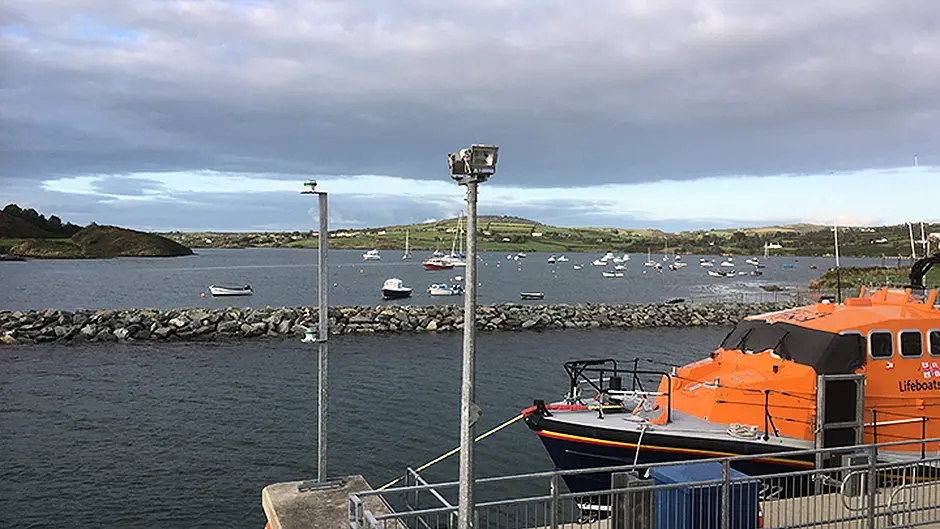There are fears that every harbour in Ireland could be affected by An Bord Pleanala's July decision to refuse Cork County Council planning permission to build a breakwater in Baltimore.
THERE are fears that every harbour in Ireland could be affected by An Bord Pleanala’s July decision to refuse Cork County Council planning permission to build a breakwater in Baltimore.
Cork County Council has now confirmed that it is to ‘revisit’ its proposal to create a breakwater in Baltimore Harbour after An Bord Pleanala (ABP) decided on July 27th to refuse the local authority’s planning application.
ABP refused the application on the basis that ‘it could not be satisfied that the proposed development would not result in a direct loss of a particular habitat within the Roaring Water Bay and the Islands Special Area of Conservation.’
ABP made the decision despite acknowledging that there was ‘a demonstrable need to improve the safety and accessibility of Baltimore Harbour’, as well as acknowledging the ‘acceptability, in principle, of the breakwater.’
A spokesperson for Cork County Council confirmed: ‘We are currently considering the detail of the decision and the associated inspector’s report and submissions.
‘In this context, Cork County Council will be seeking the advice of both internal and external ecological specialists and will also consult with other statutory stakeholders in order to explore the potential for revisiting this proposal.’
The spokesperson noted the local authority’s ‘disappointment’ at ABP’s decision and commented on the fact that the application was both ‘protracted and complex’.
Cork County Council had, in fact, applied for planning permission for a breakwater – which locals say is similar in appearance, but larger in scale, to the breakwater that is being used to good effect at the village’s RNLI station – in August 2015.
However, before 2015 was out, the Council withdrew the application because An Bord Pleanala had requested a Natura Impact Statement and subsequently resubmitted the application.
The fact that a decision on the issue kept being adjourned prompted one local councillor, Joe Carroll (FF), to speak out on the subject.
Cllr Carroll has – over the last three years – been bitingly critical of the entire planning process.
The Fianna Fáil councillor, who used to be a member of the now defunct Baltimore Harbour Board, has repeatedly stressed at West Cork Municipal District and Western Division meetings that a breakwater was needed for shelter.
During Storm Ophelia, he said, local fishing and marine leisure vessels ‘had to scurry to nearby Old Court and Union Hall, and even further afield to Castletownbere, because they could not find safe harbour in Baltimore.’
He said he was ‘greatly disappointed’ at the July decision because everything that was needed in Baltimore – in terms of infrastructure – has been put in place and the only item remaining on local people’s wishlist was the breakwater.
Cllr Carroll described the three-year planning process – which involved several requests for reviews and surveys – as ‘horrendous’ and said that in other countries, like France, ‘there would be uproar.’
Calling on the Council to reapply for planning permission sooner rather than later, Cllr Carroll said: ‘Everybody knows a breakwater is needed.’
He also expressed a deeper, darker concern that the decision could have long-term implications – not just for Baltimore, but for every harbour in the country.
‘If the decision was made on the basis of a loss of habitat, does that mean that there can be no development, no construction, in the harbour at all?’ asked Cllr Carroll.
The councillor said: ‘There is no doubt about it but the Bord’s decision is being taken seriously – not just in Cork, but nationwide, because it has implications for the entire country.
‘No matter what way you look at it, this is going to be a major hindrance to development in any harbour in the country.’ And he also expressed the view that the matter could be referred to the EU for adjudication.
Cllr Carroll’s opinion that the lost habitat ‘would come back in a short time and on a greater scale’ is supported by local businessman and RNLI coxswain Kieran Cotter.
Mr Cotter said that an existing breakwater – which was put in to protect the RNLI launch site – has, in fact, led to the creation of new wildlife habitats.
‘There are lots of shrimp, conger eels, even otters, living in or around the breakwater that was built in 2012, and there certainly weren’t any conger eels or otters there before.’
Kieran’s son, Ciaran Cotter, confirmed that the size of the Roaring Water Bay and Islands Special Area of Conservation, otherwise known as SAC, is 14,253ha and that the proposed breakwater would result in the loss of 1.57ha of marine habitat, which is 0.01% of the overall SAC.
Ciaran pointed out that a major extension to the North Pier in Baltimore was granted planning permission despite the fact that it resulted in the loss of 0.25ha of SAC’s marine habitat.
He said no one deemed that to be an issue at the time, and the same could be said of storm protection works at Cape Clear Island.
Speaking as someone who has risked his life trying to save others at sea, RNLI coxswain Kieran Cotter, said: ‘There is no escaping the fact that a breakwater is needed for a variety of reason, primarily the safety of the fishing fleet and the safety of the ferry operators to the islands and their passengers.’
Kieran said he was aware of the Council’s disappointment with ABP’s decision and he expressed his personal hope that the proposal ‘isn’t dead in the water’.
‘There is no getting away from the fact that we need to be able to provide safe harbour and safe access. These are minimum requirements and I believe that the breakwater will have to become part of the infrastructure in Baltimore, no matter how long it takes.’
In outlining the background to the issue, Mr Cotter said: ‘A group of fishermen started the Baltimore Fishermen’s Association in 1985 and, in 1986, it employed a consultant, Jim Fitzgibbon of DJ Fitzgibbon & Co, to draw up a plan to provide access to the piers, shelter for all the harbour users, as well as car parking.’
Kieran said: ‘A lot of that plan has been put in place, including an access road from the old hall down to the Church of Ireland, and from there down to the pier, where there are now about 150 car parking spaces.’
In 1994, a new access road from the old boatyard to the fisherman’s pier was provided and the North Pier was subsequently constructed – all of which effectively provided a ring road around the village. It had the net effect of allowing traffic to circulate and, by alleviating traffic congestion in the centre of the village, made Baltimore safer for pedestrians.
Kieran said: ‘These infrastructural works – which were by and large overseen by Cork County Council – were no small thing.
They were instrumental in underpinning the village’s continued growth and its widespread appeal as a tourism destination.
‘The improved access was welcomed by locals,’ said Kieran. ‘People could see the Council’s investment had enhanced the area, and local businesses, particularly those in the square, were similarly encouraged to invest in, and expand, their own businesses.’
In 2004, Adam Cronin of what was formerly Cronin Millar Consultants, but is now ByrneLooby, picked up from where Jim Fitzgibbon had left off.
The consultant engineer, who was employed by Baltimore Harbour Board – an organisation that was disbanded in 2012 – provided a revised plan that led to the improvement of the village’s pier infrastructure.
Kieran said: ‘The ferry pier was rejuvenated in 2008, and, after that, works commenced on what was known as the foul-berth, and then, one year later, we got the ro-ro slip, which allows ferries to load vehicles.’
Kieran, who runs a general store in the heart of the village, emphasised the point that ‘every stage of development created new opportunities and made the operation of the harbour far safer for everyone concerned.
‘Take, for example, the location of the ro-ro slip: it was put in place at safe distance from where the hundreds of young people converge every summer to take part in sailing classes.
‘My reason for saying that is that everyone in the village is mindful that we all have to work together and I don’t believe there is anyone who would dispute the fact that a breakwater is needed.
‘In fact,’ Kieran said, ‘I would go so far as to say it is the final piece of the infrastructure puzzle. It is my belief that Cork County Council holds the same opinion and that whatever it takes – including going back to the drawing board – we have to convince An Bord Pleanala that a breakwater will not negatively impact either the marine habitat, nor will it be visually obtrusive.’
Kieran acknowledged that there were about 22 observations –half of which were positive and half negative. He said: ‘It would be true to say that the local business community, the fishermen, the ferries, and the people living on the islands, all supported the Council’s planning application to build the 400m breakwater.’
According to the Council’s planning application, the proposed breakwater would start at the north west corner of the car park, loop in a semi-circle, and come to a stop about 100m north of the fishermen’s pier, leaving a 100m channel for vessels to enter and exit the harbour.
Mr Cotter said: ‘There is no getting away from the fact that more and more people are using the harbour – you just have to look at the increase in the number of people holidaying in the area to be able to extrapolate and see a corresponding increase in marine leisure industry, particularly in terms of whale and bird watching.
‘But the real reason a breakwater is needed is for protection – the protection of the harbour users and their property. For that, it is vital.’







